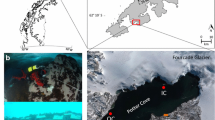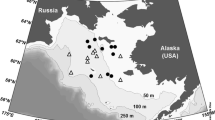Abstract.
During three "Polarstern" cruises to the ice-covered Greenland Sea (spring 1997, summer 1994, autumn 1995) studies on the under-ice habitat (morphology, hydrography, ice-algal biomass) and on the macrofaunal, autochthonous under-ice amphipods (species diversity, abundance) were carried out in order to describe environmental controls and seasonal patterns in this community. In spring, the ice underside was rather smooth and whitish, while in summer melting structures and sloughed-off ice-algal threads were observed, in autumn detritus clumps accumulated in depressions at the ice underside. Only in summer, a thin layer of warm (up to –0.6°C) and less saline (as low as S=6.3) water was found at the ice–water interface above Polar Water. Integrated ice-algal biomass was highest during autumn (2.6 mg chl a m–2) and lowest during summer (1.2 mg chl a m–2). Four species of under-ice amphipods occurred in spring and summer (Apherusa glacialis, Onisimus glacialis, O. nanseni, Gammarus wilkitzkii), but only the last species was observed at the ice underside in autumn. A. glacialis and G. wilkitzkii were equally abundant in spring; A. glacialis dominated in summer. The highest total abundance of amphipods occurred during summer (31.9 ind. m–2), compared to lower abundances in spring and autumn (5.3 and 1.1 ind. m–2, respectively). A factor analysis revealed seasonal patterns in the data set, which mainly influenced A. glacialis, and species-specific relations between several environmental factors and the distribution of under-ice amphipods. Abundance of A. glacialis was closely related to the under-ice hydrography and ice-algal biomass, whereas the other amphipod species were more influenced by the under-ice morphology. It is therefore stated that the observed thinning of the Arctic sea ice and the resulting increased meltwater input and change in morphology of floes will have a profoundly adverse effect on the under-ice amphipods.
Similar content being viewed by others
Author information
Authors and Affiliations
Additional information
Electronic Publication
Rights and permissions
About this article
Cite this article
Werner, .I., Gradinger, .R. Under-ice amphipods in the Greenland Sea and Fram Strait (Arctic): environmental controls and seasonal patterns below the pack ice. Marine Biology 140, 317–326 (2002). https://doi.org/10.1007/s00227-001-0709-1
Received:
Accepted:
Issue Date:
DOI: https://doi.org/10.1007/s00227-001-0709-1




